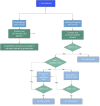Targeted Interventions to Increase Blood Pressure and Decrease Anaesthetic Concentrations Reduce Intraoperative Burst Suppression: A Randomised, Interventional Clinical Trial
- PMID: 35308563
- PMCID: PMC8931826
- DOI: 10.3389/fnsys.2022.786816
Targeted Interventions to Increase Blood Pressure and Decrease Anaesthetic Concentrations Reduce Intraoperative Burst Suppression: A Randomised, Interventional Clinical Trial
Abstract
Background: It has been suggested that intraoperative electroencephalographic (EEG) burst suppression (BSupp) may be associated with post-operative neurocognitive disorders in the elderly, and EEG-guided anaesthesia may help to reduce BSupp. Despite of this suggestion, a standard treatment does not exist, as we have yet to fully understand the phenomenon and its underlying pathomechanism. This study was designed to address two underlying phenomena-cerebral hypoperfusion and individual anaesthetic overdose.
Objectives: We aimed to demonstrate that targeted anaesthetic interventions-treating intraoperative hypotension and/or reducing the anaesthetic concentration-reduce BSupp.
Methods: We randomly assigned patients to receive EEG-based interventions during anaesthesia or EEG-blinded standard anaesthesia. If BSupp was detected, defined as burst suppression ratio (BSR) > 0, the primary intervention aimed to adjust the mean arterial blood pressure to patient baseline (MAP intervention) followed by reduction of anaesthetic concentration (MAC intervention).
Results: EEG-based intervention significantly reduced total cumulative BSR, BSR duration, and maximum BSR. MAP intervention caused a significant MAP increase at the end of a BSR > 0 episode compared to the control group. Coincidentally, the maximum BSR decreased significantly; in 55% of all MAP interventions, the BSR decreased to 0% without any further action. In the remaining events, additional MAC intervention was required.
Conclusion: Our results show that targeted interventions (MAC/MAP) reduce total cumulative amount, duration, and maximum BSR > 0 in the elderly undergoing general anaesthesia. Haemodynamic intervention already interrupted or reduced BSupp, strengthening the current reflections that hypotension-induced cerebral hypoperfusion may be seen as potential pathomechanism of intraoperative BSupp.
Clinical trial registration: NCT03775356 [ClinicalTrials.gov], DRKS00015839 [German Clinical Trials Register (Deutsches Register klinischer Studien, DRKS)].
Keywords: Burst Suppression Rate; anaesthetic intervention; electroencephalography; entropy; intraoperative neuromonitoring.
Copyright © 2022 Georgii, Kreuzer, Fleischmann, Schuessler, Schneider and Pilge.
Conflict of interest statement
The authors declare that the research was conducted in the absence of any commercial or financial relationships that could be construed as a potential conflict of interest.
Figures








References
-
- Bijker J. B., van Klei W. A., Kappen T. H., van Wolfswinkel L., Moons K. G., Kalkman C. J. (2007). Incidence of intraoperative hypotension as a function of the chosen definition: literature definitions applied to a retrospective cohort using automated data collection. J. Am. Soc. Anesthesiol. 107 213–220. 10.1097/01.anes.0000270724.40897.8e - DOI - PubMed
Associated data
LinkOut - more resources
Full Text Sources
Medical

